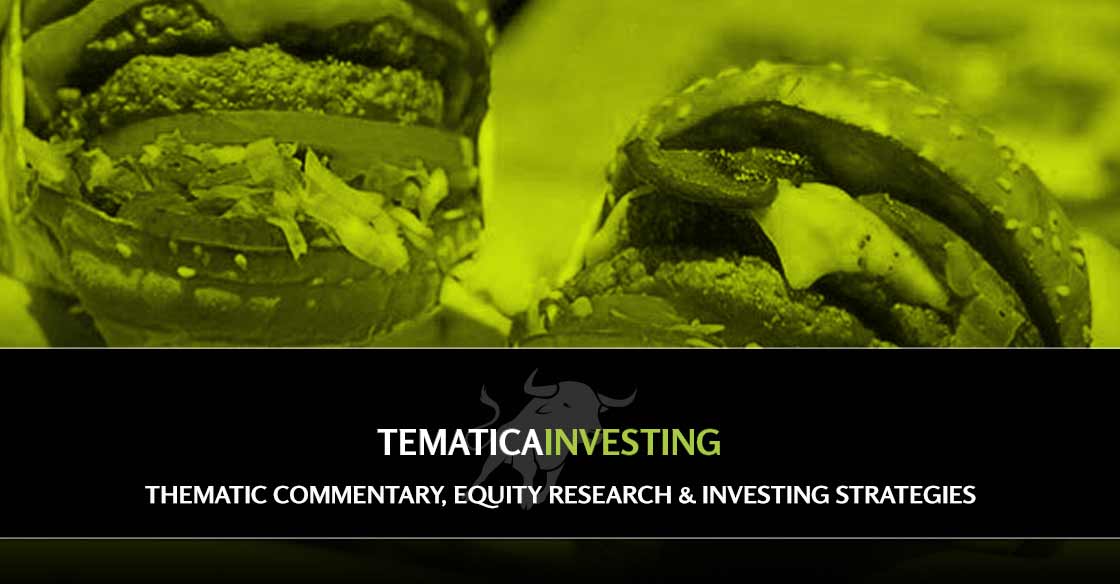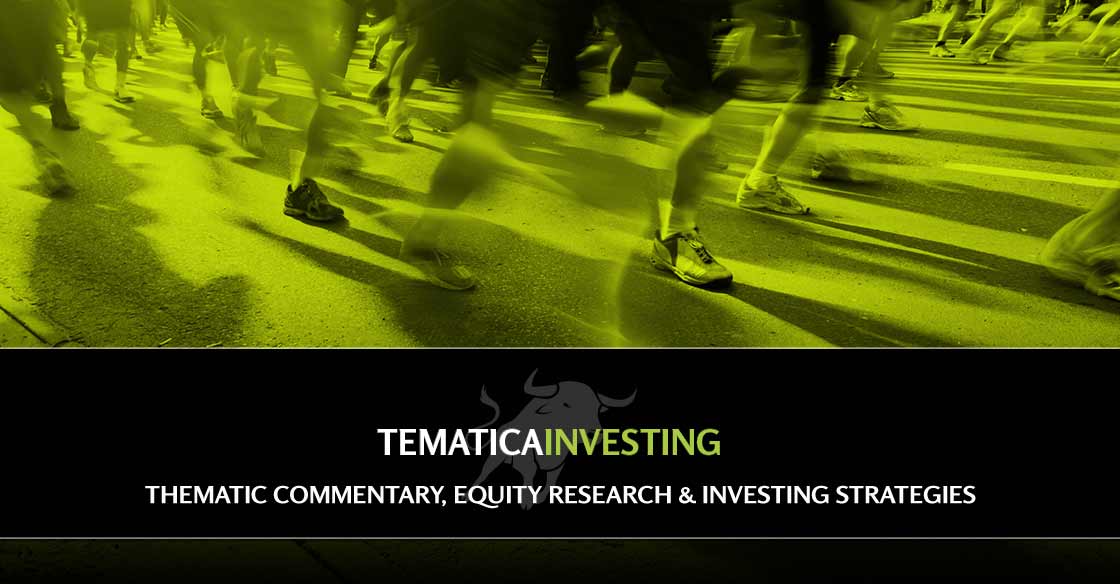WEEKLY ISSUE: A Guilty Pleasure or a Habit? In this case it’s the same
KEY POINTS FROM THIS ALERT:
- We are adding shares of Habit Restaurant (HABT) to the Tematica Investing Select List as part of our Guilty Pleasure investing theme with an $11.50 price target.
- We are boosting our price target on USA Technologies (USAT) shares to $12 from $11 following robust margin performance in the March quarter and strong prospects for more realized synergies with its Cantaloupe acquisition and new Ingenico relationship.
- After reporting March quarter earnings that saw its net asset value per share continue to climb, we continue to rate GSV Capital (GSVC) shares a Buy with an $11 price target.
After formally adding shares of Disruptive Technology company AXT Inc. (AXTI) back to the Tematica Investing fold earlier this week, we’ve got a jam-packed issue this week that includes a new recommendation that brings an active position in our Guilty Pleasure investing theme onto the Tematica Investing Select List. Let’s get to it…
Adding Habit Restaurant shares to the Tematica Investing Select List
People need to eat. That’s a pretty recognizable fact. Some may eat more than others, some may eat less; some may eat meat, others may not. But at the end of the day, we need food.
As investors, we recognize this and that means considering where and what consumers eat, and also identifying companies that are poised to benefit from other opportunities. One such opportunity is geographic expansion, and with restaurants it often means expanding across the United States.
Typically, expansion is driven by new store openings, which in turn drive sales. Tracing back its expansion over the last several years, Chipotle Mexican Grill (CMG) had to build up to 2,363 locations. Even with that number of locations, per Chipotle’s recently filed 10-K, the company still expects to “open between 130 and 150 new restaurants in 2018.” At that pace, it would take quite a while before Chipotle has as many locations as McDonald’s (MCD) (more than 14,000) or Starbucks (SBUX) (just under 14,000) in the U.S. exiting last year.
A little over a year ago, Restaurant Brands (QSR), the company behind Tim Hortons and Burger King, acquired Popeye’s in part for food-related synergies but also the opportunity to grow Popeye’s through geographic expansion. In 2016, Popeye’s had some 2,600 locations compared to more than 7,500 Burger Kings in the U.S. For those wondering, that’s greater than the 2,251 locations Jack in the Box (JACK) had in 2017.
And that brings us to a quick service with a California char-grill twist restaurant that is Habit Restaurant (HABT). With just 209 Habit Burger Grill fast casual locations in 11 states spread between the two coasts, Habit has ample room to expand its concept serving flame char-grilled burgers and sandwiches, fries, salads and shakes. And if you’re wondering how good Habit is, I took the liberty of trying its products and sampling its friendly service at one of the few East coast locations — it’s work, someone had to do it. I can certainly understand why this Guilty Pleasure company was named “best tasting burger in America” in July 2014.
In 2017, the company recorded revenue of $331.7 million from which it generated EPS of $0.16. For this year, consensus expectations have it serving up revenue near $393 million, up around 18% year over year, but EPS of $0.05 — a sharp drop from 2017.
What we’re seeing is Habit hitting an inflection point as it engages a national advertising agency, opens 30 new locations this year and contends with higher wage costs (up 6%-7% vs. 2017), as well as test markets breakfast. Inflection point stocks can be tricky largely because even as things go right there can be mishaps along the way. With the company expected to open the greatest number of new locations during the March quarter, I put the shares on the back burner in early March when they were near $10 with a note to follow up after the company reported the March quarter.
Last week, Habit issued its quarterly results with year over year revenue growth near 17%, but still out of reach compared to consensus expectations, and it also missed on the bottom line. Following that report, HABT shares fell x%, bottoming our near $8.20 before settling at $8.60.
What led to the shortfall?
During the March quarter, Habit opened 11 new company-owned locations – more than the expected 7-10 for the quarter — more than one-third of its targeted new openings for 2018. Another factor was rising costs in the form of inputs (beef and chicken in the protein complex and French fries) as well as higher labor costs, particularly in California, during its peak promotional activity.
Now for the positive developments. First, to offset those higher costs the company is implementing a 3.9% menu price hike at the end of May. Second, its expansion plans – with another 20 or so company restaurants this year and 6-8 franchised locations —remain on track with but at a slower open rate compared to the March quarter.
This expansion should help improve the company’s geographic footprint further as it follows the three new east coast locations openings (Maryland, New Jersey) opened during the March quarter. During the earnings call, the company shared that roughly 20% of its company-operated growth will be on the east coast and about 50% will be drive through locations. On another note, the company is testing a breakfast menu, which in our view is a long-term positive given that per NPD Group findings, breakfast is the fastest growing meal with 80% of that growing being had a quick service restaurants.
Now here’s the thing – no matter what metric you look at for the shares OTHER than P/E they are cheap. The shares are currently trading at 8.0x on an enterprise value to 2018 earnings before interest, taxes, depreciation and amortization (EBITDA) basis, which is more than 40% discount to the peer group that includes Jack in the Box (JACK), Wendy’s (WEN) and other quick-service restaurants. Some of that discount is warranted as Habit has to wind its way through some likely growing pains, but as I shared above the longer-term driver of the company’s success will be geographic expansion. It bears repeating — we’ve seen this time and time again with restaurant companies ranging from Dunkin’ Donuts to Starbucks (SBUX), Chipotle (CMG) back in the day and Del Taco (TACO) more recently. There is also the chance that another quick service chain will pull a Restaurant Brands-Popeye’s move to jumpstart its own growth metrics.
With more than 25% upside to our $11.50 price target, which is still a discount to the quick service peer group, and modest downside following the news of the March quarter, the risk to reward profile in HABT shares is rather tasty. As the company continues to expand its footprint East, I’ll continue to review the impact on the business – good and bad — as well as the bottom line and what it means for our price target.
- We are adding shares of Habit Restaurant (HABT) to the Tematica Investing Select List as part of our Guilty Pleasure investing theme with an $11.50 price target.
Robust margins lead us to boost our price target for USAT shares
Yesterday morning USA Technologies (USAT) reported March quarter results that pushed the shares higher in morning trading, and has us nudging our price target to $12 from $11 in response. For the quarter, USA achieved EPS of $0.04, beating the consensus by $0.03, despite missing revenue expectations for the period by just over 6%, as the company’s gross margin rose to more than 33% vs. 25.0% in the year-ago quarter.
That jump in profitability reflects continued growth in USA’s total mobile payment connection base as well as sustained growth in the dollar transaction volume carried over those connections. Exiting the quarter, USA’s total connection base stood at 969,000 across 15,600 customers (up from 504,000 and 12,400, respectively exiting March 2017), with transaction volume climbing to $318 million, up 57% higher year over year. USA’s margins also benefitted from realized synergies from its November 2017 acquisition of Cantaloupe Systems. As a reminder, Cantaloupe utilizes cloud-based, mobile technologies to offer an integrated end-to-end vending and payment solution for cashless vending, dynamic route scheduling, automated pre-kitting and merchandising and inventory management.
We continue to see that as extremely synergistic with USA’s mobile payment platform for vending and other unattended retail applications, with more incremental revenue and profit synergies to be had in the coming quarters. Central among those synergies is new customer engagements, which should drive additional mobile payment connections and customer growth. Also adding to that is the recently inked multi-year with payment processing firm Ingenico that pairs Ingenico’s hardware, software, security and services products with USA’s mobile payment services platform. As the company’s results and guidance, including the margin commentary, are digested, we expect 2018 EPS to move higher from the pre-earnings report consensus of $0.06 for this year and $0.13 next year.
Do we continue to think that USAT will emerge as a potential takeout candidate as the mobile payment industry continues to grow and mature? Yes, but that does not factor into our new price target of $12.
- We are boosting our price target on USA Technologies (USAT) shares to $12 from $11 following robust margin performance in the March quarter and strong prospects for more realized synergies with its Cantaloupe acquisition and new Ingenico relationship.
Net asset value per share continues to climb at GSV Capital
Last night shares of Asset-lite company GSV Capital (GSVC) reported mixed March quarter results with a beat on the bottom line and a miss on the top line. As I’ve shared before, the real driver of GSV’s shares price is not revenue or earnings, but the trajectory of its investment portfolio, which we measure through its net asset value per share. Exiting the March quarter, that portfolio’s net assets across 29 positions totaled approximately $210.5 million, or $9.99 per share up from to $9.64 per share at the end of 2017, and $8.83 per share exiting the March 2017 quarter.
The company’s top five holdings, which included privately held Palantir Technologies, Spotify (SPOT), Dropbox (DBX), private company Coursera and NESTGVS, accounted for 58% of GSV’s investment portfolio exiting March vs. 39% in the year ago quarter. With consensus price targets of $157 and $33 for Spotify and Dropbox shares, respectively, we continue to see added lift in the company’s net asset value per share. Should the company’s largest holding in Palantir Technologies go public as is widely postulated or be acquired, we would have a third leg to the stool driving GSV’s net asset value growth higher.
Helping the net asset value per share comparisons, GSV repurchased 1.1 million shares during the quarter for $6.2 million, which reduced the shares outstanding by 5% year over year. Following the upsizing of the company’s share repurchase program by an additional $5 million, GSV has roughly $8.8 million remaining. At current levels, the company could repurchase another 1.25 million shares, shrinking its outstanding share count by 6%.
- After reporting March quarter earnings that saw its net asset value per share continue to climb, we continue to rate GSV Capital (GSVC) shares a Buy with an $11 price target.


